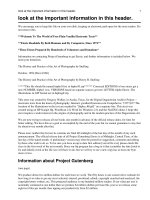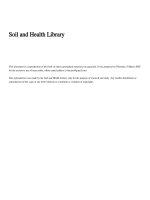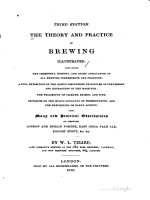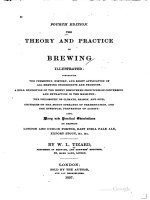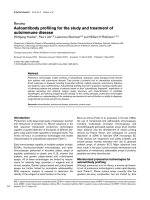The study and practice of writing english (1914)
Bạn đang xem bản rút gọn của tài liệu. Xem và tải ngay bản đầy đủ của tài liệu tại đây (33.79 MB, 360 trang )
]
II
^RITING ENGLISH
OMEK.AMDASHMUN
VICTORIA UNIVERSITY LIBRARY
TORONTO, ONTARIO
yi
f
THE STUDY AND PRACTICE
OF WRITING ENGLISH
BY
GERHARD
R.
LOMER,
M.A., PH.D.
Instructor in English in the School of Journalism
Columbia University in the City of New York
AND
MARGARET ASHMUN,
M.A.
Formerly Instructor in English in
The University of Wisconsin
BOSTON NEW YORK CHICAGO
HOUGHTON MIFFLIN COMPANY
(OTbc fttoersibe
prc?? Cmnbri&Qc
COPYRIGHT,
1914,
BY GERHARD
R.
LOMER AND MARGARET ASHMUN
ALL RIGHTS RESERVED
1937
CAMBRIDGE MASSACHUSETTS
U S A
.
.
.
CONTENTS
I.
ESTABLISHED USAGES
1.
2.
1
Punctuation
30
Capitals
33
3. Italics
35
4.
Abbreviations
5.
The Representation
of
Number
37
39
6. Syllabification
II.
7.
Rules for Plurals
40
8.
Possessives
43
9.
Rules for Spelling
45
GRAMMATICAL REQUIREMENTS
1.
2.
Sequence
3. Shall
III.
49
Syntax
4.
Voice
of
Tenses
55
and Will
58
.61
5.
Irregular Verbs
6.
Sentence Structure
7.
Paragraphs
63
.
67
98
THE USE OP LANGUAGE
1.
2.
3.
4.
5.
The Study of Language
Some Suggestions for the Study
The Use of the Dictionary
.
Synonyms
Some Common Latin Roots
.
.
.
.
.120
.
.
.121
127
133
135
7. Suffixes
English
.
Words
134
6. Prefixes
8.
Ill
of
Words
for Analysis
136
CONTENTS
iv
10.
The Idiomatic Use of Prepositions .
.
in
used
Words
Foreign
commonly
English
11.
Phrases from Foreign Languages
9.
.
.
.
138
.
.
.
140
142
145
12. Style
IV.
13. Figures of
Speech
14. Diacritical
Marks
157
164
15.
Words commonly mispronounced
16.
Common
Errors in Speech and Writing
....
165
167
184
17.
Vulgarisms
18.
Hackneyed Expressions
19.
Hackneyed Quotations
185
.
.
.
*
.
.
.186
.
WRITTEN COMPOSITION
1.
Steps in Theme-Writing
191
2.
Outlines
193
3.
The Preparation
4.
Marks
5.
Short-Theme Subjects
203
6.
Long-Theme Subjects
206
7.
How
8.
Quotations
9.
References and Footnotes
10.
of
Manuscript
for the Correction of
Themes
....
to take Notes
199
202
208
.......
Making a Bibliography
.
215
219
221
V. FORMS OP DISCOURSE
1.
Description
224
2.
Exposition
241
3. Definition
251
4.
Argumentation
254
5.
Biography
Narration
267
6.
...........
7.
A
8.
The Drama
9.
Translation
Specific
260
269
Study of the Short Story
.294
.
.
308
CONTENTS
v
VI. CORRESPONDENCE
312
and Friendly Letters
1.
Social
2.
Commercial Correspondence
319
APPENDIX
A
INDEX
Working Library
of
Books on Composition
.
.
.
329
.
.
335
THE STUDY AND PKACTICE
OF WBITING ENGLISH
ESTABLISHED USAGES
i.
PUNCTUATION
is
PUNCTUATION
a convenient mechanical device for
indicating or assuring the unity, the coherence, or the
emphasis implied in the written expression of thought.
Punctuation is not an end in itself; it merely helps to suggest pauses, inflections, and intonations that in oral expression are of great value in making a thought clear. In the
use of punctuation, the student must master certain recog-
nized conventions that depend upon a few underlying
principles.
The more important general rules admit of little
latitude for personal opinion in their application, since
they are tacitly accepted by all who aspire to be careful
writers. Other rules, though less binding, are indicative of
what is considered good form in writing and are a proof of
literary training
and experience.
In minor matters, a
degree of personal freedom in punctuation is permitted.
On the whole, until a writer has become thoroughly in-
formed as to the best practice, he will do well to allow
himself very little license in the use of the marks of punctuation. He should carefully apply the rules that have
been agreed upon by students of language as the most
efficient in
supplementing the written word.
ESTABLISHED USAGES
2
The
chief
marks
of punctuation are:
Period
Question mark, or interrogation point
Exclamation point
Colon
Semicolon
?
!
:
;
Comma
,
Dash
*
(above the
Apostrophe
Quotation marks
"
Parentheses
(
)
Brackets
[
]
"
*
line)
'
Hyphen
The Period
1. A complete declarative or imperative sentence should
be followed by a period.
(a) The sun is shining.
(6)
Give
me
the
rifle.
EXCEPTION. The rule given above is extremely important,
and it should, in general, be strictly adhered to; nevertheless,
good usage furnishes an exception: Two or more sentences
that are closely connected in thought may be separated merely
by commas, if these sentences are very short, and are parallel in
construction.
(a)
(6)
She laughed, she sang, she danced.
It rained, it hailed, it snowed, and
N.B. For a further note on
Comma, page 15.
it
blew great guns.
under the
this point, see
2. A fragment or a subordinate part of a sentence
should not be followed by a period, unless there is nothing
present for the partial sentence to adhere to, and unless the
sense
is clearly and completely understood.
Bad: He was very inadequately prepared. Which fact soon
became apparent.
PUNCTUATION
3
He was very inadequately prepared, which fact
soon became apparent.
Bad: I had not reckoned with my enemy. As I was afterCorrect:
ward
to learn.
had not reckoned with my enemy, as I was afterward to learn.
NOTE: Sometimes a fragment of a sentence is accepted as a
complete thought. The expressions Yes, Not so, Of course, etc.,
are really condensed sentences, and may properly be followed
by periods. In conversation, a fragment of a sentence may
often, with good reason, be followed by a period as if it were a
Correct: I
complete sentence.
"Did you
"On
3.
An
the
it
on the floor?"
What have you
to say?"
abbreviation should be followed
M.D.;
1.
find
floor.
e.g.;
by a
period.
Assoc.; Bros.; ibid.; R.S.V.P.
The Question Mark
The question mark should follow a direct question.
Have you heard the news?
CAUTION: The question mark should not be used after an
mam
indirect question unless the
sentence in which the indirect
question is embedded is also interrogative in character.
Right:
He asked me whether I had heard the news?
He asked me whether I had heard the news.
Right:
Did he ask you whether you had heard the news?
Wrong:
2. The question mark
truth of an assertion.
is
used to indicate doubt as to the
George Chapman was born in 1559(?).
The question mark should not be used to call
Correct:
3.
tion to an ironical expression.
Undesirable:
Better:
He
He
certainly
certainly
is
a
is
a brilliant
brilliant
atten-
(?) young person.
young person.
ESTABLISHED USAGES
4
The Exclamation Point
1.
The exclamation
point
is
used after interjections,
exclamatory sentences, and words or names pronounced
with emotional emphasis.
Do you hear?
There are horses many! Now they stop!
Ah, now
Feet on the threshold!
Listen! Listen!
MAETERLINCK.
2.
The exclamation point should not be used where the
comma will do
(a)
(6)
Oh, dear, no. I never thought of such a thing.
"For the land sake, Susannah," cried Arietta, advancing
3.
as well.
upon
her,
"what
are
The exclamation point
you doin'?"
is
parentheses, for the sake of
an
mentary on what has been
recommended.
said.
Undesirable:
He
praised
my
a noble example to his
Better:
He
praised
example to
my
sometimes used, within
comThis practice is not to be
ironical or astonished
meekness
(!)
and
said
it
was
sisters.
meekness, and said
it
was a noble
his sisters.
The Colon
I.
The
colon
is
used as a formal introduction to an
important word
or expression, a list, a series of statements
or questions, or a quotation of some length.
(a) He sent in an order for the following books: George
Meredith's The Egoist; Mrs. GaskelTs The Life of Charlotte
Bronte; John Fiske's The Beginnings of
New
Eng-
and Hawthorne's Mosses from an Old Manse.
Not content with this, Hawthorne adds a few comments at the end, exactly as would be done in a formal
land;
(6)
sermon:
dream
"Woe
with his
His name and person
for the high-souled youth,
of Earthly Immortality!
PUNCTUATION
5
unknown; his history, his way of life, his plans, a
mystery never to be solved; his death and existence
equally a doubt!" C. A. SMITH: The American Short
utterly
Story.
There were two things that I looked upon with equal
abhorrence: the slatternly housekeeper and the slave to
a domestic routine.
(c)
The
colon is sometimes used to introduce a series of
which
are an illustration or an elaboration of a
thoughts
preceding general thought. In such a case, the material
following the colon is in a sense in apposition with that
preceding. This use of the colon is not to be recommended
2.
to the unskilled writer.
Everywhere the signs of the gentle faith apideographs and symbols are chiseled upon the
faces of the rocks; its icons smile upon you from every
shadowy recess by the way; even the very landscape
betimes would seem to have been moulded by the soul of
LAFCADIO
it, where the hills rise softly as a prayer.
Permissible:
pear:
its
HEARN: Glimpses
of Unfamiliar Japan.
The Semicolon
The semicolon
occupies, theoretically, a position midIt can be made to
way between the period and the comma.
show, at the same time, logical connection and grammatical separation. It is a most expressive mark, and the ability
to use
it
effectively is
one of the characteristics of the
trained writer.
I.
The semicolon may be used to separate the two or
of a compound sentence in which the conjunc-
more parts
tion
expressed or understood.
(a) The animal was apparently as exhausted as I was; that
was one comfort.
is
(&)
In his desire to be particular, Gissing describes a
man
on one page as a lawyer and on another as a dentist; but
this is a detail hardly worth mentioning.
ESTABLISHED USAGES
6
In such a sentence as that given above, the quality of the
second clause seems to demand a more positive mark than the
comma. The semicolon gives just the right shade of suspense
between the two parts of the sentence,
shows, as it were, a
pause for consideration and conclusion. There are many
similar cases in which the semicolon can be made equally significant as a division between the parts of the compound sentence.
2.
The semicolon may be used
to separate a series of
long subordinate sentence elements.
The semicolon
combined
clauses
is
in
especially valuable
if
the phrases or
a sentence have commas within them-
if they are so long as to present a confusing or a formidable appearance. Even where the subordinate elements are
not long, they are often given an individual value through
selves, or
being separated by the semicolon.
There I learned that the stranger had arrived late one dark
rainy night, after the landlord and his family had gone
to bed; that he had remained three days in his room, venturing out only in the evening and the early morning;
and that he had departed at last as mysteriously as he
had come.
customary to place a semicolon before the conadverbs therefore, hence, accordingly, however,
nevertheless, also, otherwise, moreover, and others of a like
3. It
is
junctive
nature.
This rule should, in general, be very strictly applied.
(a) She was a woman; therefore she made excuses for him in
her heart.
(6)
(c)
My
cousin had lived the greater part of his life in
France; thus it happened that, when he arrived at our
house that day, not one of the family recognized him.
I do not think that he is at home; however, I will make
inquiries at once.
4.
thus
The semicolon should usually precede as, namely, and
when they are used to introduce examples and illus-
trations.
PUNCTUATION
7
plaintiff solemnly denied two of the charges; namely,
breaking into the desk, and destroying the memoran-
The
dum
of his father's liabilities.
5 . A semicolon may be used to separate the parts of any
sentence when a comma would be misleading or insufficient.
He killed the duck and the chicken, and the child
stood watching him in fascinated horror.
Better: He killed the duck and the chicken; and the child
stood watching him in fascinated horror.
Bad:
EXERCISE
1.
2.
3.
4.
Punctuate the following sentences:
The problems that confront us now are two ought we to go
and ought we to publish our reasons
He sent me home for his heavy overcoat hence I was not at
my desk when the secretary called to see me
The walls were covered with vines and brilliant flowers
nodded at the windows
You gave me no
peace until I
more readily
clear we must
made a promise
therefore I
capitulated the
5.
6.
To make
this
distinguish three classes
who
stand in a certain relation to education in modern England
first the schoolmasters who nominally manage the schools
secondly the mass of the public who send their sons to the
schools thirdly the educational theorists who write books
He was courteous not cringing to superiors affable not familiar to equals and kind but not condescending or supercilious
to inferiors
did not believe his story nevertheless I pretended to put
confidence in the tale
7. I
8.
9.
all
Thus pressed
I gave them my most sufficient reasons whereat
they burst into immoderate roars of laughter
We hold these truths to be self-evident that all men are
created equal that they are endowed by their Creator with
certain inalienable rights that among these are life liberty
10.
and the pursuit of happiness
Three states have already passed such laws namely Montana
Colorado and California
ESTABLISHED USAGES
8
11.
The
following groups of men are dissatisfied those who out of
own means contributed to the cause those who in one
their
way or another assisted with the actual labor and those who
whether through poverty or indifference did nothing at all
12.
The man who thus
exquisitely repainted these pictures in
gifts vivid memories of childhood ex-
words had three great
periences the heart of a child to interpret
ful power of verbal expression
13.
them and a wonder-
Richardson with perfectly unconscious humor divided his
characters into three classes
men women and
Italians
14. Kipling feels the presence of romance in shot and shell as well
as in buff jerkins in existing superstitions as well as the old in
the lightning express as in the stage-coach in the fishing
schooner as in the viking ship in the loves of Mulvaney and
Dinah as in Ivanhoe and Rowena in the huge python as in the
fire-breathing dragon
Like the sonnet the short-story must be a unit giving expression to one emotion or a series of emotions possessing a unity
of tone its characters must be few its action must be simple
15.
something but it suggests more
This was the way it happened four years ago my company
sent me out to Montana to investigate the titles of some
ranches that they intended to buy
The captain was by this tune ready to look into the matter
moreover he felt that he had really made a mistake
it tells
16.
17.
The Comma
1.
that
The comma
is,
is used to set off parenthetic material,
material thrown into a sentence for purposes of
explanation.
(a)
(6)
The
question, I own, puzzled me.
He, however, was likely to ride his hobby in his own
way.
He would arrive, it was true, somewhat after dark.
f
(c)
2.
The comma should be used
to inclose a
noun
in
apposition.
(a)
On the doorstep stood Bill Gray, the widow's eldest son.
(6)
Mr. Hennessey, the foreman, was much impressed.
PUNCTUATION
At Verona, the county
(c)
EXCEPTION This
:
(a)
rule
is
seat,
9
we stopped
for dinner.
to be disregarded,
When the appositive is a title that has become a part of
a name.
Peter the Hermit; Philip the Fair; John the Evangelist.
When
(6)
noun
the appositive is so closely connected with the
modifies that a separation is illogical.
it
The
first
was
his friend Charles.
When a word or a phrase is spoken of in such a way that
(c)
attention
3.
to speak
called to
is
(1)
The word
(2)
The
it
for its
own
sake.
not in good use.
expression "Cheese it" was once a popular
slang phrase.
The comma
is
used to inclose a
that
direct address,
want to
(a) I
swell is
is,
name
or title used in
as a vocative.
say, friends, that
this sort of thing
must
stop.
(6) I believe,
4.
name used
(a)
(6)
5.
Mr. Farley, that we have made a mistake.
The comma should be used
after another to
Our
train stopped at
to inclose a geographical
relative location.
Hope, Idaho.
My
brother who lives in Rouen, France,
America next year.
is
coming to
The comma should be used
a compound sentence
little
show
no
or
If
if
to separate the clauses of
those clauses are short and have
interior punctuation.
the clauses are long or if they have commas within themsemicolon may be used to separate them.
selves, the
(a)
(6)
His wet feet were freezing, and his exposed fingers were
growing numb.
He was a warm-whiskered man, but the hair on his face
did not protect the high cheek-bones and the eager nose
that thrust
itself
aggressively into the frosty air.
ESTABLISHED USAGES
10
6.
The comma should be used
to set off a dependent
clause preceding its independent clause.
(a)
When
I
looked at
my watch
again, I found that
it
had
stopped.
(6)
Although he was an extremely busy man, he never
me when I asked him.
refused to help
7 A series of adjectives should usually be separated by
commas.
(a) The balloon rose higher into the clear, cold, bracing air.
(6)
He was a
tling,
stubby
little
man
with a red face and a bris-
close-cropped mustache.
NOTE There
:
are
many occasions on which this rule is to be
disregarded. If the adjective nearest the
part of the idea expressed by the noun,
noun seems to be a
likely that the
other adjectives modify the whole ensuing combination of
noun and adjective; in such a case, no comma need be placed
between the last and the next to the last adjective.
He wore a short black alpaca
it is
coat and a large white cravat.
Short seems to modify black alpaca coat, which combination
may be considered as a unit. No comma is needed
of words
between short and black. Large, modifying white cravat, need
not be followed by a comma. It is not always easy to tell
whether the comma is desirable or not. A study of the best
usage will be helpful. On the whole, the modern tendency is to
lessen rather than to increase the amount of punctuation used
in ordinary prose discourse.
8. A comma should precede and, or, or nor, used to connect the last two links of a sequence of three or more:
(a) Me*rimeVs stories are hard, ironical, and cynical.
(6)
You ought to write, telegraph, or telephone your family.
A notion exists that a comma should not be used
NOTE:
before and.
This idea
is illogical.
The above
rule should be
strictly applied.
9. Absolute phrases should be set off by commas.
The house being in a state of disorder, we decided to go to a
hotel.
PUNCTUATION
10.
The comma should
follow
11
any expression equivalent
to he said, introducing a direct quotation.
Stepping close to the little old woman, he shouted in her
ear,
11.
"That
train left
A comma may
an hour ago."
be used to set
off
an introductory
phrase of considerable length or of complicated structure.
With the kindest intentions and the most unimpeachable
motives, I was made to appear a detestable notorietyseeker.
off
NOTE: Very short introductory phrases should not be
by any mark of punctuation.
In the late afternoon I took a walk along the
set
river.
12 . A comma may be inserted where a pause is needed in
a sentence and no other mark of punctuation is suitable.
A
comma may be used where
13.
obscurity in a sentence.
it will
remove any
Into the envelopes filed there, goes a wealth of material
clipped from the magazines of the day.
14.
A comma
should set
off
a nonrestrictive phrase or
clause.
A full discussion of the punctuation of restrictive and nonand
restrictive phrases
The omission of
the
clauses
comma
is
given below.
with restrictive phrases and
clauses
A restrictive adjectival phrase or clause is one that modifies
a noun or pronoun in such a
way
as to be essential to
the completeness of the sentence in which the phrase or
clause occurs. It cannot be omitted without changing the
sense, since
it is
modifies that
it
so closely attached to the substantive
it
meaning of that submanner. The restrictive
restricts or limits the
stantive in a clear
and
definite
phrase or clause is not separated by any
tion from the noun it modifies.
mark
of
punctua-
ESTABLISHED USAGES
12
The glass filled with the clear water was
placed upon the table; that filled with the brownish
liquid was put away in the cupboard.
Restrictive phrase:
The phrases filled with the clear water and filled with the
brownish liquid are restrictive; in each case they point out the
that is, restrict or narrow down the applicaglass intended,
tion of the word glass. They could not be omitted without destroying the sense of the sentence.
The student who ignores the regulations
not be permitted to take part in the play.
Restrictive clause:
will
The
clause
who
ignores the regulations tells definitely
what
meant. It restricts or narrows the application of the
noun student. It cannot be omitted without destroying the
sense that is intended. No comma should precede the clause.
student
is
mother had given
Correct:
She
Correct:
A gentleman has been defined as a man who has no
visible
The use of
lost the ring that her
means
the
her.
of support.
comma
with nonrestrictive phrases and
clauses
A
nonrestrictive adjectival phrase or clause modifies,
though very loosely, a noun or pronoun; the information
gives is not essential to the grammatical completeness or the sense of the sentence. Since it is merely paren-
that
it
thetic in character, a nonrestrictive phrase or clause can
be omitted without serious damage to the sentence. Such a
clause should be separated from its substantive by commas.
Nonrestrictive phrase: Her basket, filled with berries that
she had gathered in the woods, was found upon the grass.
Here the identity of the basket is clear, whether the phrase
be omitted or not. The phrase does not restrict the application
of the noun basket; it simply gives parenthetical information
about the basket in question. It is nonrestrictive, and should
be set off from the rest of the sentence by commas.
Nonrestrictive clause: Arthur Doulton, who had ignored all
the regulations, was forbidden to take part in the play.
is identified by his name; the clause who
Here the miscreant
PUNCTUATION
13
had ignored all the regulations does not point him out, but merely
adds a comment upon him. The clause is nonrestrictive, and is
properly set off by commas.
Correct: I
who had given much attention
was forced to confess his igno-
asked Mr. Jaffrey,
to such matters, but he
rance.
Coned: This book, which
I
tory of chemical secrets,
had once regarded as a reposito seem quite com-
now began
monplace.
The
test
far restrictive
and
nonrestrictive phrases
and
clauses
the foregoing remarks upon restrictive and nonrestrictive phrases and clauses, it will be seen that there is a
From
by means of which the nature of the modifier can be
ascertained, and with it the necessity for the use of comtest
merely leaving the phrase or clause out
of the sentence and then judging whether the sense in-
mas. This test
tended
is
is
impaired:
(a) If the phrase or clause cannot be omitted without destroying
the sense of the sentence, it is restrictive. It should not be set
off from the
word
it
modifies.
(6) // the phrase or clause can be omitted without
damage to
meaning of the sentence, it is nonrestrictive.
It should be separated from the rest of the sentence by
commas.
the intended
NOTE There may be a few cases in which the application of
:
this test will
still
leave doubt; in such cases, one
must decide by
reference to the context, or content himself with remaining
unenlightened.
The
tive
following table
and nonrestrictive
may
be helpful in the study of
clauses:
restric-

